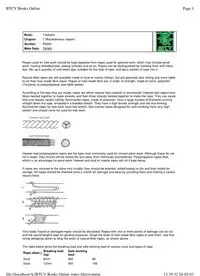
Rope Types 2003 PDF
Preview Rope Types 2003
BTCV Books Online Page 1 Book: Toolcare Chapter: 7 Miscellaneous repairs Section: Ropes Meta Data: Details Ropes used for tree work should be kept separate from ropes used for general work, which may include pond work, hauling wheelbarrows, towing vehicles and so on. Ropes can be distinguished by marking them with fabric dye. Mix up a quantity of cold water dye, suitable for the type of rope, and dip a section of rope into it. Natural-fibre ropes are still available made of sisal or manila (hemp), but are generally less strong and more liable to rot than man-made fibre ropes. Ropes of man-made fibre are, in order of strength, made of nylon, polyester (Terylene) or polypropylene (see table below). According to the way they are made, ropes are either hawser-laid (cabled) or kernmantel. Hawser-laid ropes have fibres twisted together to make strands, and then three strands twisted together to make the rope. They can easily kink and require careful coiling. Kernmantel ropes, made of polyester, have a large number of filaments running straight down the rope, encased in a braided sheath. They have a high tensile strength and are non-kinking. Kernmantel ropes for tree work have low stretch. Kernmantel ropes designed for rock climbing have very high stretch and should never be used for tree work. Hawser-laid polypropylene ropes are the type most commonly used for conservation work. Although these do not rot in water, they should still be stored dry and away from chemicals and batteries. Polypropylene ropes float, which is an advantage for pond work. Hawser-laid sisal or manila ropes will rot if kept damp. If ropes are returned to the store very muddy, they should be washed, coiled loosely to dry and then coiled for storage. All ropes should be checked once a month for damage and wear by uncoiling them and making a careful visual check. Very badly frayed or damaged ropes should be discarded. Ropes with one or more points of damage can be cut and the sound lengths kept for general purposes. Singe the ends of man-made fibre ropes to seal them. Use fine string (whipping twine) to whip the ends of natural-fibre ropes, as shown above. The table below gives the breaking load and safe working load of various sizes and types of rope. Rope (diam.) Breaking load (kg) Safe working load Sisal 8mm 480 80 Sisal 12mm 950 158 file://localhost/A:/BTCV Books Online ropes-filer/content 13:39:32 26-02-03 BTCV Books Online Page 2 Sisal 16mm 1780 296 Sisal 24mm 4060 676 Manila 8mm 540 90 Manila 12mm 1070 178 Manila 16mm 2030 338 Manila 24mm 4570 761 Polypropylene 8mm 960 160 Polypropylene 12mm 2030 383 Polypropylene 16mm 3500 583 Polypropylene 24mm 7600 1266 Polyester 12mm 3000 500 Nylon 10mm 2080 346 Nylon 12mm 3000 500 Nylon 14mm 4100 683 All content copyright © 2001 BTCV Ltd. Registered charity No. 261009 file://localhost/A:/BTCV Books Online ropes-filer/content 13:39:32 26-02-03
